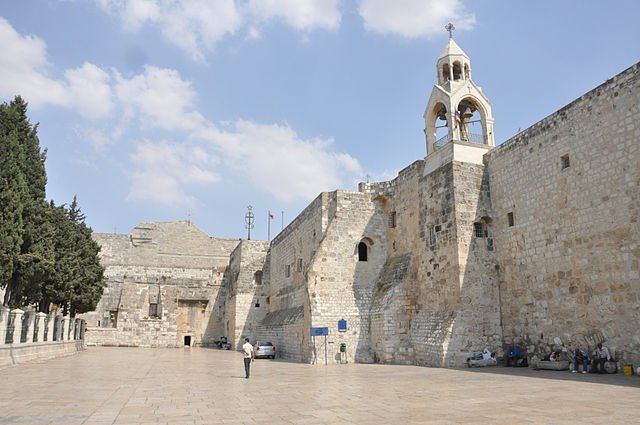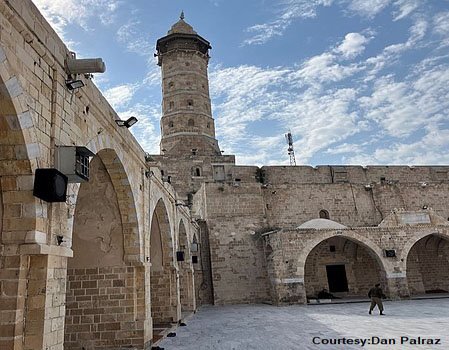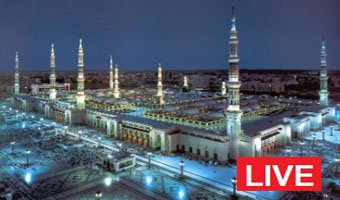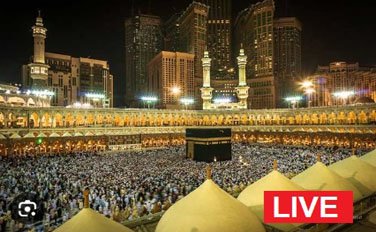Al-Aqsa Mosque: A Journey Through Time and Faith

Towering over Jerusalem’s Old City, the Al-Aqsa Mosque isn’t just a place of worship; it’s a potent symbol of faith, a historical landmark, and a vibrant tapestry woven with stories, miracles, and profound spiritual significance. Embark on a journey to explore the Al-Aqsa Mosque, its enduring legacy, and the transformative experience it offers visitors.
A Journey Through Time :
- 7th Century AD: According to Islamic tradition, the Prophet Muhammad (PBUH) is miraculously transported from the Kaaba in Makkah to the Al-Aqsa Mosque during the Night Journey (Israʾ wal-Miʿraj). Here, he leads prayers with prophets of the past.
- 637 AD: Muslim forces led by Caliph Umar ibn Al-Khattab conquer Jerusalem and establish Islamic rule over the city. The Temple Mount, where Al-Aqsa is located, is cleansed of idols and prepared for Muslim worship.
- 691-692 AD: The Dome of the Rock, another significant Islamic landmark, is built on the Temple Mount by Caliph Abd al-Malik.
- Centuries Following: The Al-Aqsa Mosque undergoes various renovations and expansions throughout Islamic history by different rulers.
- 1967 AD: Israel occupies East Jerusalem, including the Old City and the Al-Aqsa Mosque. This event sparks ongoing tensions and access restrictions for Palestinians.
- Today: Al-Aqsa Mosque remains the third holiest site in Islam and a powerful symbol of Palestinian identity. It is a functioning mosque with designated prayer areas and a focal point for religious gatherings and cultural events.
Conversations Echoing Through the Ages
Imagine the momentous events that transpired within these walls. Prophet Muhammad’s (PBUH) prayers with past prophets would have resonated with a spiritual energy that continues to be felt today. The murmurs of scholars debating theology, the echoes of prayers chanted for centuries, and the dialogues between pilgrims from across the Muslim world all contribute to the rich tapestry of the Al-Aqsa Mosque’s history.
Miracles Woven into the Fabric of Faith
The Night Journey (Israʾ wal-Miʿraj) itself is considered a central miracle in Islam. Prophet Muhammad’s (PBUH) miraculous transportation from Makkah to Jerusalem and his ascension to heaven hold immense spiritual significance for Muslims worldwide. The presence of the Al-Aqsa Mosque as the starting point of this miraculous journey further cements its sacred status.
Duas for Peace, Unity, and Preservation
Standing within the serene atmosphere of the Al-Aqsa Mosque, visitors can find solace by offering prayers (duas):
- For Peace in Jerusalem (Quran 2:251): “wa la tasta’jilu bi-l-qur’āni qabla an yuqضىa ilayka wahyuhu [wahyuhu] wa qul rabbi zidnī ‘ilman [ilman]” (And do not hasten with the Qur’an before its revelation is completed to you, and say, “My Lord, increase me in knowledge”) (interpreted as a prayer for peace, a verse revealed concerning Jerusalem)
- For Unity and Harmony Among Muslims (Quran 3:103): “Wa’tasimu bi habl Allahi jami’an wa la tafarraqu [tafarraqu]” (And hold firmly to the rope of Allah all together and do not become divided)
- For the Preservation of the Al-Aqsa Mosque (Quran 15:41): “Inna arsalna malaikatana ‘alayka bi-rūhin al-haqqi yuqawwibuka [yuqawwikum]” (Indeed, We sent down upon you the spirit of truth to strengthen you) (interpreted as a prayer for Allah’s protection of the mosque)
A Beacon of Faith and Resilience
The Al-Aqsa Mosque boasts a breathtaking architectural complex, featuring courtyards, prayer halls, and a glistening dome. The intricate mosaics, calligraphy, and stained glass windows reflect the artistic heritage of Islamic civilization. Despite the challenges faced, the Al-Aqsa Mosque continues to function as a vibrant center of worship, scholarship, and cultural expression.
More to Explore:
- Due to the political situation, access to the Al-Aqsa Mosque can be restricted. It’s advisable to check for updates on entry regulations.
- When visiting the mosque, dress modestly with shoulders and knees covered.
- Photography is usually permitted, but be respectful of worshippers engaged in prayer.
- Explore the vibrant Muslim Quarter of the Old City and delve deeper into the rich tapestry of Palestinian
The Dome of the Rock: A Splendid Jewel on the Temple Mount

Gleaming atop Jerusalem’s Temple Mount, the Dome of the Rock isn’t just a magnificent architectural marvel; it’s a powerful symbol of faith, a historical landmark, and a testament to artistic mastery. Let’s embark on a journey to explore the story behind this iconic structure, its enduring legacy, and the profound experience it offers visitors.
A Journey Through Time :
- 637 AD: Muslim forces led by Caliph Umar ibn Al-Khattab conquer Jerusalem. The Temple Mount, considered a holy site by Jews and Christians, is designated a place of Muslim worship.
- 691-692 AD: Umayyad Caliph Abd al-Malik orders the construction of the Dome of the Rock, aiming to commemorate the sanctity of the Temple Mount and establish a grand Islamic landmark in Jerusalem.
- Centuries Following: The Dome undergoes restorations and renovations throughout history, preserving its grandeur. It becomes a revered Islamic site and a source of inspiration for artists and architects.
- 1967 AD: Israel occupies East Jerusalem, including the Temple Mount. This event sparks ongoing tensions and access restrictions.
- Today: The Dome of the Rock remains a significant Islamic landmark and a popular tourist destination. While not a functioning mosque, it serves as a powerful symbol of Islamic heritage in Jerusalem.
Conversations Echoing Through Time
Imagine the dialogues that might have resonated within the shadow of this magnificent dome. Architects and artisans would have debated the design, citing passages from the Quran (perhaps Surah Al-Baqarah [The Cow], verse 117: “We have made the Kaaba a direction for the people and a place of security. So worship Allah at the House of Worship and do not attribute any partners to Him”) to ensure their creation aligned with Islamic principles. Pilgrims and worshippers from across the Islamic world would have shared stories and prayers, their voices echoing within the vast octagonal space. Today, visitors continue these conversations, marveling at the artistry and reflecting on the historical and religious significance of the Dome.
Miracles Woven into the Fabric of Faith
While not directly attributed to the Dome itself, the site holds immense significance for Muslims. Islamic tradition narrates that Prophet Muhammad (PBUH) ascended to heaven from the location where the Dome now stands during the Night Journey (Israʾ wal-Miʿraj). This miraculous event, mentioned in Surah Al-Najm [The Star] verse 1, (“By the star of descending orbit – I do not speak of what I see – Except by the permission of [Allah], and what the sight has seen is of the greatest”) imbues the entire Temple Mount with a sense of wonder and spiritual importance.
Duas for Peace, Understanding, and Preservation
Standing in the shadow of the Dome’s golden dome, visitors can find solace by offering prayers (duas):
- For Peace in Jerusalem (Quran 2:251): “wa la tasta’jilu bi-l-qur’āni qabla an yuqضىa ilayka wahyuhu [wahyuhu] wa qul rabbi zidnī ‘ilman [ilman]” (And do not hasten with the Qur’an before its revelation is completed to you, and say, “My Lord, increase me in knowledge”) (interpreted as a prayer for peace, a verse revealed concerning Jerusalem)
- For Understanding and Tolerance Among Faiths (Quran 2:256): “La ikraha fi d-dīni qad waddaha al-huda min al-ghayya [ghayya] faman yakfur bi-ṭṭāghūti wa yu’minu bi-llahi faqaḍa amsaka bi-‘urwatin wuthqā lan yanqadiʿa lahā bi-yad [yad]” (There is no compulsion in religion. [For] The right course has become clear from the wrong. So whoever disbelieves in the false deity and believes in Allah has grasped the most trustworthy handhold, unbreakable forever)
- For the Preservation of the Dome of the Rock (Quran 15:41): “Inna arsalna malaikatana ‘alayka bi-rūhin al-haqqi yuqawwibuka [yuqawwikum]” (Indeed, We sent down upon you the spirit of truth to strengthen you) (interpreted as a prayer for Allah’s protection of the mosque)
A Legacy in Stone and Splendor
The Dome of the Rock features an octagonal design with a shimmering gold dome. The intricate mosaics, geometric patterns, and calligraphy inscriptions showcase Islamic art and craftsmanship
Church of the Nativity: A Beacon of Hope in Bethlehem

Standing amidst the vibrant city of Bethlehem, the Church of the Nativity isn’t just a historical landmark; it’s a revered Christian holy site, a symbol of hope and peace, and a testament to the enduring power of faith. Let’s embark on a journey to explore the story behind this sacred church, its enduring legacy, and the profound experience it offers visitors.
A Journey Through Time :
- 1st Century AD: According to Christian tradition, Jesus Christ is born in a humble manger in Bethlehem. Shepherds are the first to witness the newborn baby, guided by a dazzling light (interpreted as the Star of Bethlehem).
- 327 AD: Roman Emperor Constantine the Great commissions the construction of a church over the cave believed to be the birthplace of Jesus.
- Centuries Following: The Church of the Nativity undergoes renovations and restorations throughout history. It becomes a major pilgrimage destination for Christians worldwide.
- 2012: UNESCO designates the Church of the Nativity and the Birthplace Route of Bethlehem as a World Heritage Site.
- Today: The Church of the Nativity remains a significant Christian holy site and a popular tourist destination. It is a shared space overseen by several Christian denominations, each with designated prayer areas.
Conversations Echoing Through the Ages
Imagine the hushed whispers of pilgrims for centuries past, filled with awe and reverence as they stood at the very spot where Jesus is believed to have been born. Debates amongst theologians, the murmur of prayers offered in countless languages, and the joyful carols sung during Christmas celebrations would have woven a rich tapestry of sound within these walls. Today, visitors from all walks of life continue these conversations, reflecting on the significance of the birthplace of Jesus and the message of hope it embodies.
Miracles Woven into the Fabric of Faith
The very foundation of the Church of the Nativity is steeped in miracles. The birth of Jesus Christ himself, as recounted in the Bible, is considered a miraculous event. The guiding star, the visit of the shepherds, and the significance of the manger all hold immense spiritual importance for Christians.
Prayers for Peace, Hope, and Compassion
Standing within the serene atmosphere of the Church of the Nativity, visitors can find solace by offering prayers or meditations:
- For Peace (Matthew 5:9): “Blessed are the peacemakers, for they will be called children of God.”
- For Hope (Romans 15:13): “May the God of hope fill you with all joy and peace in believing, so that by the power of the Holy Spirit you may abound in hope.”
- For Compassion (Luke 6:36): “Be merciful, just as your Father is merciful.” (These are just a few examples, visitors can choose prayers or meditations from their own traditions)
A Beacon of Faith and Humanity
The Church of the Nativity features a combination of architectural styles reflecting its long history. The Grotto of the Nativity, the cave where Jesus is believed to be born, is a small and humbling space, emphasizing the simplicity of the event. Despite the complexities of the surrounding region, the Church of the Nativity continues to stand as a beacon of hope, peace, and the enduring power of faith.
More to Explore:
- Due to the shared space between denominations, specific dress codes may not be enforced, but respectful attire is recommended.
- Photography is usually permitted, but be mindful of worshippers engaged in prayer or meditation.
- Explore the vibrant city of Bethlehem, birthplace of King David and a center of Palestinian culture. Visit Manger Square, site of the Christmas tree lighting ceremony, and delve deeper into the rich Christian heritage of the region.
The Al-Omari Mosque (Great Mosque of Gaza)

The Al-Omari Mosque, also known as the Great Mosque of Gaza, holds a significant place in Islamic history and the cultural heritage of Palestine.
Name:
- Al-Omari Mosque (referencing Caliph Omar)
- Great Mosque of Gaza (due to its size)
History:
- Believed to be built on the site of an ancient Philistine temple.
- 5th century: A Byzantine church was erected.
- 7th century: Following the Muslim conquest, the church was converted into a mosque by Caliph Omar ibn al-Khattab’s generals. Named after him in his honor.
- 8th-11th centuries: The mosque underwent renovations and additions.
- 1033: An earthquake damaged the minaret.
- 1149: Crusaders captured Gaza and built a large church on the site.
- Later Muslim rule: The mosque was restored and continued to serve as a religious and social center.
- Notably, the mosque has been damaged or destroyed several times throughout history but rebuilt each time.
Miracles and Duas:
There aren’t widely known documented miracles associated with the Al-Omari Mosque. However, mosques in general are considered sacred spaces for prayer and spiritual connection. Muslims believe in the power of dua (supplication) offered in holy places.
Additional Resources:
- You can find more information about the mosque’s history and architectural details online by searching for “Great Mosque of Gaza” or “Al-Omari Mosque Gaza”.
Important Note:
The current status of the Al-Omari Mosque is unfortunately uncertain. It has reportedly been damaged in recent conflicts.
The Kulliyat Mosque: A Pillar of Faith in Ramallah
The Kulliyat Mosque in Ramallah, Palestine, serves as a cornerstone of the city’s Islamic heritage. While details about its exact origins remain elusive, its presence speaks volumes about the enduring role of faith in the community.
A Historical Wellspring
Estimated to be built sometime in the early 20th century, the Kulliyat Mosque emerged during a period of renewed focus on Islamic education in Palestine. The mosque likely served as a center of learning, its halls echoing with the recitation of Quran, Hadith, and scholarly discussions. Perhaps the interpretations formulated within its walls even influenced Islamic thought in the region.
A Sanctuary for the Soul
The Kulliyat Mosque transcends its function as a place of worship. For many, it’s a sanctuary, a place of solace and spiritual connection. While documented miracles are rare, the mosque might hold a special place in the hearts of believers, where prayers find an audience and anxieties find release.
Duas for Peace and Guidance
Here are some supplications (Duas) you can recite while visiting the mosque:
- For guidance: “Allahumma inni a’udhu bika min al-shaytanir-rajim. A’udhu billahi Rabbil-falaqi min sharri ma khalaq, wa min sharri ma zala ya’malu, wa min sharri ghibati’l-kutub, wa min sharri man yasubbu fi’l-‘uqad [O Allah, I seek refuge in You from the accursed devil. I seek refuge in Allah, the Lord of the dawn, from the evil of what He has created, and from the evil of that which descends, and from the evil of the whisperers [devils] who spread slander, and from the evil of the one who whispers evil into the knots (of the hearts of men)].” (Quran, Surah an-Nas)
- For peace: “Rabbana atina fid-dunya hasanatan wa fil-akhirah hasanatan wa qina ‘adhaban-nar [Our Lord, give us good in this world and good in the Hereafter and keep us from the torment of the Fire].” (Quran, Surah al-Baqarah)
A Legacy of Faith
The Kulliyat Mosque stands as a testament to the enduring Islamic traditions of Ramallah. It serves not only as a place of worship but also as a wellspring of knowledge and a sanctuary for the community.
Further Exploration
Information about the Kulliyat Mosque is limited online. To delve deeper, consider reaching out to local Islamic scholars, historians, the mosque’s imam or administrators, or even residents familiar with its history.
Imagery
Since a verified image of the Kulliyat Mosque is unavailable, you can use royalty-free images of mosques with a similar architectural style, making it clear they are not the Kulliyat Mosque itself. Alternatively, commission a local photographer to capture the mosque’s unique beauty.
Table of Contents
List of mosques in the State of Palestine
West Bank
Nablus area
- Great Mosque of Nablus – Nablus
- Al-Hanbali Mosque – Nablus
- Al-Khadra Mosque – Nablus
- Al-Masakin Mosque – Nablus
- Nabi Yahya Mosque – Sebastia
- An-Nasr Mosque – Nablus
- Al-Nurayn Mosque – Qusra
- Al-Tina Mosque – Nablus
Ramallah area
- Ein Misbah Mosque – Ramallah
- Jamal Abdel Nasser Mosque-Ramallah
- Mosque of Lower Ramallah – Ramallah
Bethlehem area
- Al-Hamadiyya Mosque – al-Khader
- Mosque of Omar – Bethlehem
Hebron area
- Amir Sanjar al-Jawli Mosque – Hebron
- Ibrahimi Mosque – Hebron
- Ishaqiyyah Mosque – Hebron
- al-Qazzazeen Mosque – Hebron
- Sheikh Ali al-Bakka Mosque – Hebron
Jenin area
- Fatima Khatun Mosque – Jenin
- Shiekh Zayid Mosque – Jenin
Gaza Strip
- Aybaki Mosque
- Abu Khadra Mosque
- Great Mosque of Gaza – Old City of Gaza[1]
- Ibn Marwan Mosque – Tuffah
- Ibn Uthman Mosque – Shuja’iyya
- Mahkamah Mosque – Shuja’iyya
- Sayed al-Hashim Mosque – Old City of Gaza
- Al-Shamah Mosque – Old City of Gaza
- Sheikh Zakariyya Mosque
- Katib al-Wilaya Mosque – Old City of Gaza
Beit Hanoun
- Umm al-Nasr Mosque – Beit Hanoun
Deir al-Balah
- Al-Khader Mosque – Deir al-Balah
Jabalia
- Omari Mosque – Jabalia
East Jerusalem
East Jerusalem’s status is disputed by Israel and Palestine, currently unilaterally under sovereign control of Israel.
- Al-Aqsa – Old City of Jerusalem
- Al-Khanqah al-Salahiyya Mosque – Old City
- Marwani Mosque – Old City
- Mosque of Omar – Old City
- Abdeen Mosque – Wadi al-Joz
- Sultan Ibrahim Ibn Adham Mosque – Beit Hanina
Related Post: Beautiful and Ancient Mosques in Syria
Also Read: Exploring Egypt’s Mosques
May You Like: Al Quran with Urdu Translation mp3

